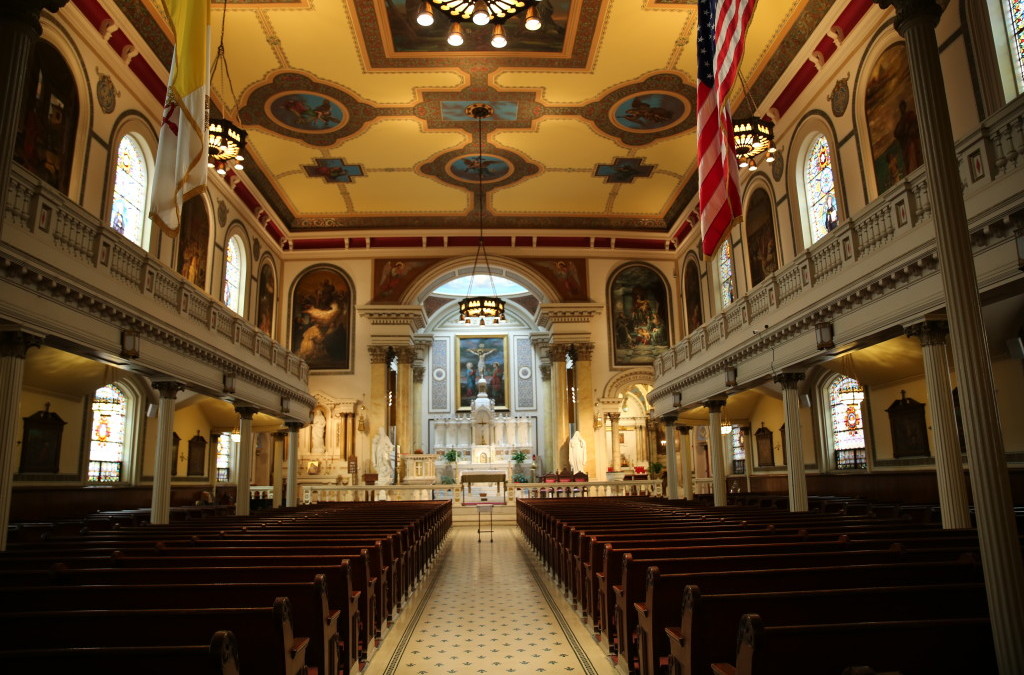This post was originally posted at the National Catholic Register.
St. Augustine’s Historic Church Gets More Historic
It is the first foundation of the Augustinian Order in the United States (1796), and at the time, it was the fourth and largest Catholic Church in Philadelphia. The original church was burned down on May 8, 1844, during the anti-Catholic and anti-immigrant Nativist Riots of 1844. As a result of that experience, William Penn’s “Holy Experiment” was tested in the courts, and the Philadelphia Police Department was created. In 1922, when the Benjamin Franklin Bridge was built, the entire area around the church was lowered, changing the position of the original front door. Movie buffs recognize its interior as the setting for pivotal scenes in the movies The Sixth Sense and Shooter.
Recently, Old St. Augustine’s received another historic recognition, this time by the Philadelphia Historical Commission. The magnificent frescoes that adorn the church’s ceiling, which were painted in 1848 as the church was being rebuilt after the fire destroyed the first church, are some of the oldest frescoes in the entire country. Considering how difficult it is to create and maintain a fresco, this is a real feat.
Father Bill Waters of the Order of St. Augustine, the church’s pastor, spoke recently about what that means.
“If you had asked me what a fresco was last year, I wouldn’t have been able to tell you!” he said with a smile on his face. “A fresco,” he went on to explain, “is painted on wet plaster, as opposed to dry or canvas, so the real talent is being able to do the artistic work really quickly before it dries, so it is a real challenge.”
The Italian painter who created the frescoes, Nicola Monachesi, had the added challenge of painting them whilst lying on his back, as did Michelangelo in the Sistine Chapel.
It is not insignificant — for those who know their Augustinian saints — that Monachesi was from a little town in Italy called Tolentino, also the home of another Nicola, who later became a saint, St. Nicholas of Tolentino. Was Monachesi drawn to work with the Augustinians because of his tie to one of their saints? Perhaps.
“I’d like to think that in his prayer life,” Father Waters said, “he reflected on what life was like for Augustine in heaven, and so, like all artists, he put something very concrete down to reflect his thoughts and prayer.”
The historical importance of these beautiful frescoes was uncovered by the tireless research conduced by Celeste Morello, a local historian.
The main fresco, which dominates the ceiling — called Augustine in His Glory — depicts the soul of St. Augustine being taken up into heaven, with the Blessed Virgin Mary and Christ Child looking on and the eye of God in a triangle at the top. Angels bearing the tools of Christ’s passion surround the main painting in their own decorated circles.
But the beauty of St. Augustine’s doesn’t diminish when you lower your eyes. Everywhere you look in this church, you see something that reminds you of the remarkable life of the patron of the Augustinian Order, whose feast the Church celebrates on Aug. 28. Paintings alongside the clerestory windows depict scenes from St. Augustine’s life, from his baptism by St. Ambrose to the writing of his many books and sermons, from the legend of his meeting with the angelic child on the beach to his holy death.
The sanctuary is flanked by statues of St. Augustine and his indefatigable mother, St. Monica (whom the Church honors on Aug. 27), and a beautiful painting of Jesus’ crucifixion is just below the reminder that “The Lord Seeth.” These words are a reminder of the same words that could be seen in St. Augustine’s as it burned to the ground in 1844, which must have been a fright for the anti-Catholic arsonists.
Today, St. Augustine’s is a thriving parish frequented by many of the young families moving in to this section of Philadelphia, which is called Old City. St. Augustine’s has also been designated as the National Shrine of the Santo Niño de Cebu, a Filipino devotion to the Christ Child. Every August, thousands of members of the Filipino community come to St. Augustine’s for the Sinulog Festival and a procession through the old city streets, all the while reminding the city that the Catholic faith is as strong as ever here, below the shadow of the bridge.
While Father Waters and the Augustinian community are happy that the church is being celebrated yet again, they recognize that these great graces bring great obligations, too. “There is added responsibility to preserve these historic paintings,” Father Waters said. “In a city that is so historic, and a building that is so historic, we have a responsibility now to make sure they are preserved.”
Old St. Augustine’s is a great place to come and admire not only the beauty of the art, but reflect on the life of St. Augustine, a very human and approachable saint.
One of Father Water’s favorite quotes from St. Augustine is: “Lord, make me chaste, but not yet.”
One of mine: “Our hearts are restless until they rest in You.”
Those who would like to help the Augustinians’ efforts to preserve and maintain these frescoes can find the contact information for the friars on their website, St-AugustineChurch.com.

